The Stevens Motor
Manufacturing Company
| In 1899 the four Stevens brothers, George, Jack, Joe,
and Harry decided to set themselves up in business to
manufacture petrol engines for all kinds of applications. As
a result they founded the Stevens Motor Manufacturing Company.
The brothers needed cash to finance the new project, and so
initially,
three of them, George, Joe, and Jack took other jobs until
Harry could get the company established. Luckily this happened very
quickly, the brothers soon returned, and petrol engines were
developed for many uses. |
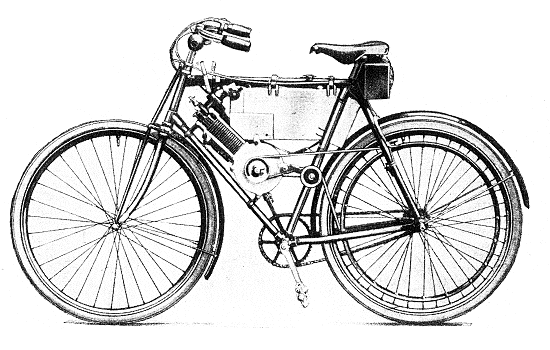
The Stevens brothers first motor-bicycle. A BSA
bicycle with the old 'Mitchell' engine fitted to the frame. |
Harry soon became interested in powered transport and
fitted their old 'Mitchell' engine to a BSA bicycle that had
been lying around the works.
The engine was inclined forwards and mounted to the
frame. The ignition was supplied by a trembler coil. A large metal rim was fitted to the back wheel for a belt
drive.
A leather
belt was wrapped around it, and around a pulley on the
engine. |
| Apart from the unreliability of the engine, the machine
was a great success. It was admired by many people,
including William Clark who ran the Wearwell Cycle Company. William Clark was also interested in
producing powered vehicles, and on 26th October, 1899 he set up the Wearwell Motor Carriage Company Limited to produce vehicles at their
premises in Pountney Street. This was situated on the site that is
now occupied by J. W. Braithwaite & Son Limited, bookbinders and
finishers. Wearwell produced a four- wheeled vehicle,
powered by two Butler, 2¼hp. engines, mounted side by side. In 1899 it was
displayed at the National Cycle Show at Crystal Palace, but not
generally liked.
When he saw the Steven's machine, he realised
that it would make an ideal product for his company, because it performed
extremely well, and of course Wearwell already made
bicycles. All that would be needed was the engine and a few
modifications to a standard machine. Joseph Stevens & Company
already supplied Wearwell with spokes and screws, so both
companies were well known to each other. An agreement was
made
with Stevens, and a contract drawn-up. Stevens agreed to supply a
minimum number of engines each week, which were to be fitted to heavy duty
bicycles. |
| The new machine was called the Wearwell-Stevens motor bicycle and first appeared in the spring of 1901. It
was fitted with 2½hp. air-cooled, 4 stroke
Stevens engine, with automatic inlet valve, and mechanically
operated side exhaust valve.
The engine was mounted above the front
down tube, and had accumulator ignition, a surface carburettor,
and a twisted leather belt drive to the back wheel. It sold
for 42 guineas.
The machine proved to be very popular, and an improved version
was shown at the 1902 National Cycle Show at Crystal Palace. Improvements included a choice of surface or spray carburettor and
modifications to the wheels and frame.
Demonstrations were given at
the exhibition, the price was reduced to £40, and orders poured in.
In 1903 further changes were made. The rear wheel was now driven by
a 'Lincona' vee belt, and the surface carburettors were discontinued
in favour of the spray type. |
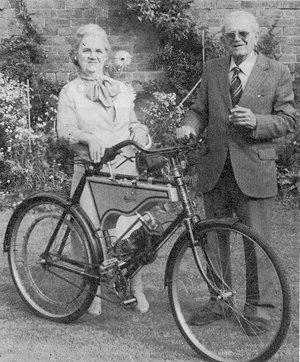
Mr. and Mrs. Albert Clarke with a 1901 Wearwell-Stevens
motorcycle. Photo courtesy of the late Geoff Stevens. |
|
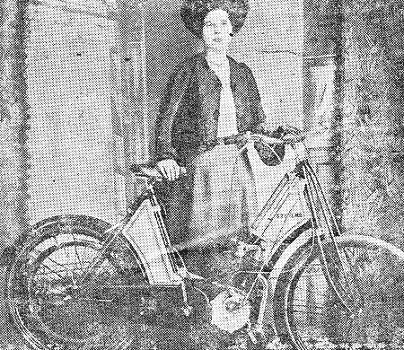
Lily Stevens and the first Stevens
motorcycle.
|
During 1903 the brothers produced a one-off Stevens
motorcycle, the
first motorcycle to be completely designed and built by
them.
It used all of their own parts and was more substantially
built than the Wearwell-Stevens machines.
Lily Stevens was the first
person to ride the machine on Wolverhampton's roads, to become the
town's first lady motorcyclist.
Lily's younger sisters Ethel and
Daisy also rode the machine. Ethel was only 14 years old at
the time. One day whilst riding the machine up Darlington
Street, a policeman stopped her and asked if she had a
license. She pretended to be her elder sister and later
produced Lily's license at the police station. |
| 1903 saw the introduction of the 'Motette' powered
tricycle, a modified version of the two and a half horse
power bicycle.
The front wheel was replaced with a two-wheeled axle,
onto which an upholstered wicker seat was attached. The
machine sold for 53 guineas. A conversion for two wheeled machines was
available for £16.5s.0d.
Unfortunately both of these products proved
to be unpopular. |
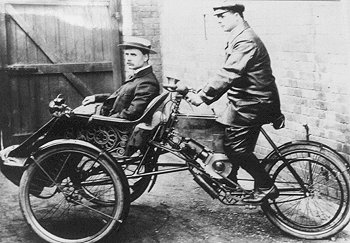
A 'Motette' with Harry Stevens as passenger, and Fred Adey driver.
Photo courtesy of the late Geoff Stevens. |
|
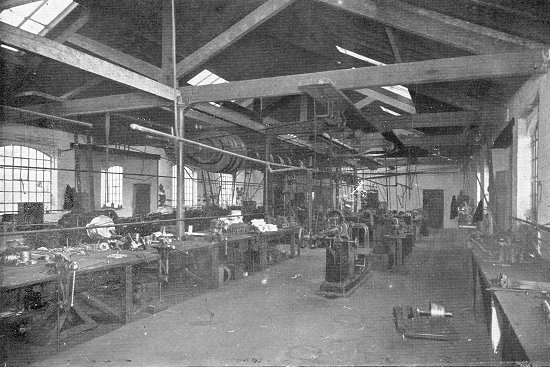
Part of the main workshop at Pelham
street. |
Stevens' engines continued to sell extremely well and a
wide range of new models soon became available.
The company quickly outgrew the Tempest Street premises and so in February
1904, both of the Stevens' companies, J. Stevens and Company,
and the Stevens Motor Manufacturing Company moved to Fort Works, at the end
of Pelham Street. |
| After the move to Pelham Street, both companies joined
together to form the Stevens Motor Manufacturing Company
Limited. The new company was registered
on 10th December, 1904 with a maximum private share capital of
£5,000. The subscribers were Joseph Stevens senior, George
Stevens, Harry Stevens, W. H. Haden (gentleman), T. E. Lowe
(accountant), and F. R. W. Hayward (solicitor). |
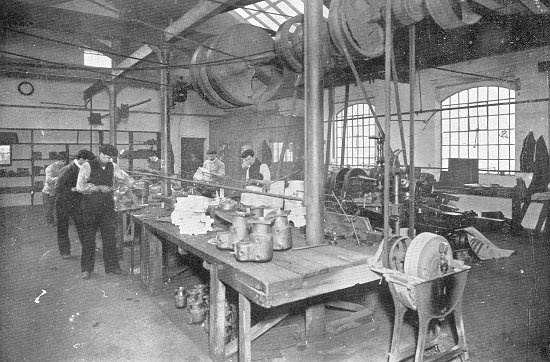
Another corner of the main workshop at
Pelham street. |
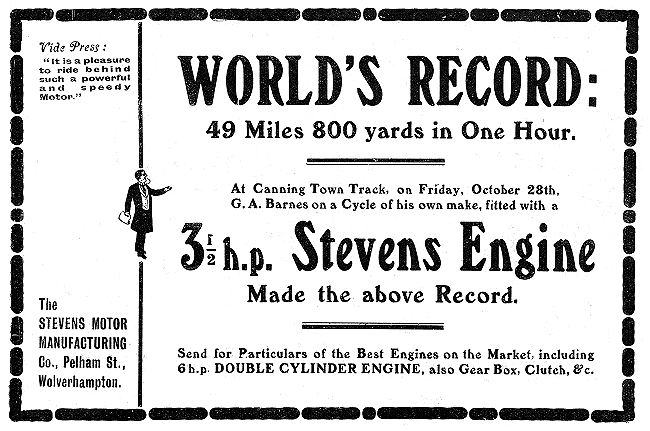
An advert from 'The Motor' 8th November, 1904.
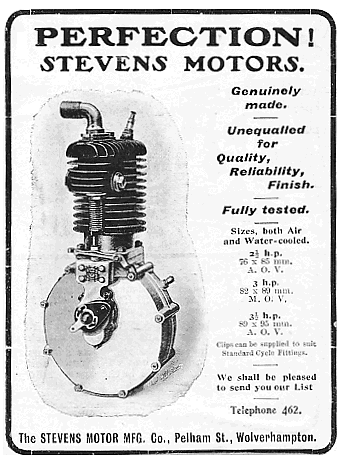 |
|
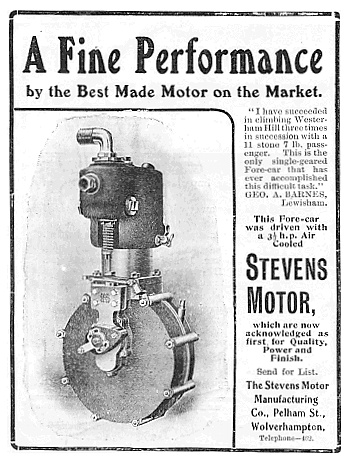 |
|
An advert
from 'The Motor' 6th April, 1904. |
|
An advert
from 'The Motor' 1905. |
|
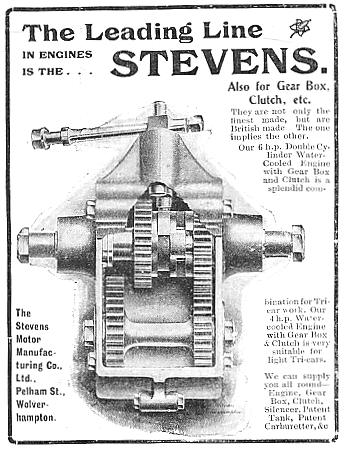 |
|
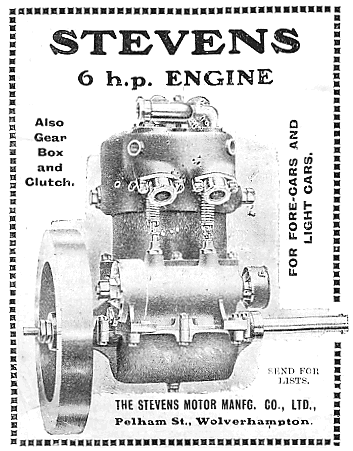 |
|
An advert
from 'The Motor' 1905. |
|
An advert
from 'The Motor' 28th March, 1905. |
|
|
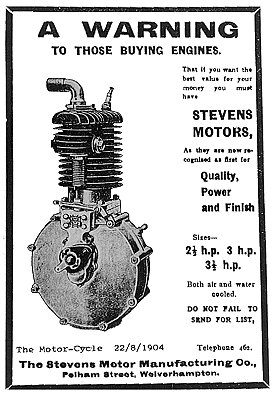
A 1904 Stevens engine advert. |
In 1904 Wearwell launched a range of more
substantially built models under the the name of 'Wolf'.
These were fitted with Stevens air or water cooled engines,
and could be supplied with a clutch. The engine was
vertically mounted near the bottom bracket. All went well until the summer of 1905
when a slump in the motor industry led to a fall in sales of engines. This
continued for some time and it became essential to safeguard the
screw and rivet part of the business from the vagaries of engine
sales.
This was achieved by the formation of the Stevens Screw
Company Limited in 1906, which moved to premises on the eastern side
of Retreat Street. The company was run by Joseph Stevens
senior, and two of his daughters, Lily and Daisy. At this time
brothers George, Joe, and Jack Stevens temporarily found
other jobs until things improved and the company could
support them again. Between 1906 and 1908 George worked
for the Commercial Autocar Company, based at Hereford. |
| The Stevens Industrial Set from
1904, built around a Stevens two cylinder vertical engine,
which
had a pair of water-cooled cylinders. It was shown at the Stanley
Show. The cylinders, the jacket, and
heads for the two cylinders were all cast in one piece.
It weighed
79lbs. and produced between 5 and 6hp.
From the Motor Cycle, 14th November,
1904. |
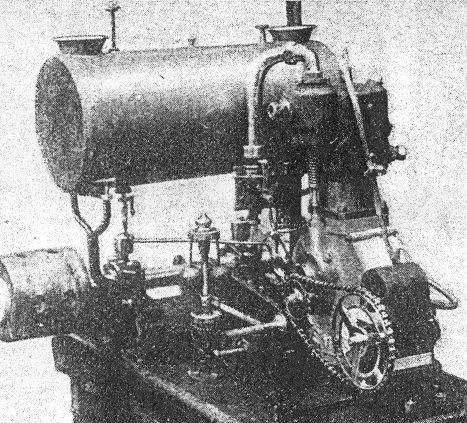 |
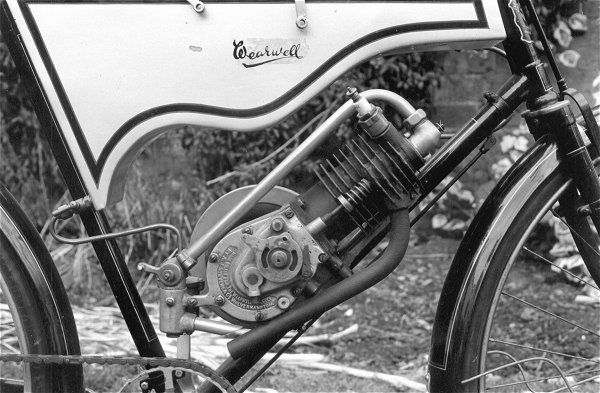
A Wearwell machine fitted with a Stevens engine and an external
flywheel. Courtesy of the late Geoff Stevens. |
At this time the brothers designed and developed a new range of
engines in readiness for the end of the depression. The new products ranged from a 4hp. single cylinder,
water or air cooled engine, several 2 cylinder engines from 6hp. to
10hp. and two 4 cylinder water-cooled engines rated at
16hp. and 18hp.
From 1907 Stevens also made around 500 engines for the
Australian motorcycle manufacturer Lewis. |
|
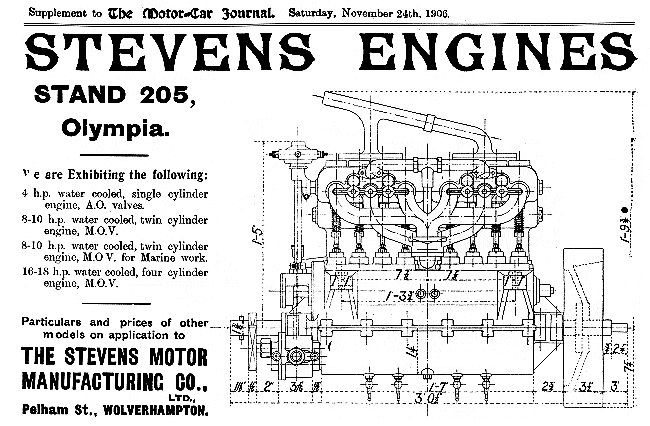
An advert from the November 24th, 1906 edition of 'The Motor Car
Journal'. Courtesy of Ray Jones. |
| Luckily Wearwell sales were still going strong, and the
range of 'Wolf' machines was increased. The engines in the
new range of
motorcycles included 2½hp., 3¼hp.
and 4hp. single cylinder, a
3hp. V-twin, a 4½hp. and a 5hp. vertical twin. Harry also designed a
new type of cork inserted clutch, which was available as an extra. The
machines sold from 37 to 42 guineas. New versions of the 'Motette' were
also produced. These were available as passenger and commercial types.
The lighter machines used 4½hp. or 5hp. water-cooled vertical twin
engines, with a 2 speed gearbox and clutch. They sold for 75 guineas.
The heavier versions were built like a car with a steering wheel and
body. They used a 7hp. or 8hp. water-cooled, vertical twin engine, a 3
speed gearbox with clutch, and sold for 100 or 105 guineas. |
| The engine opposite was developed for use
in light cars. The advert includes a testimonial written by
George A. Barnes of Lewisham:
"I have succeeded in climbing Westerham Hill three times in
succession with an 11 stone 7lb passenger. This is the only
single-geared Fore-car that has ever accomplished this difficult
task."
|
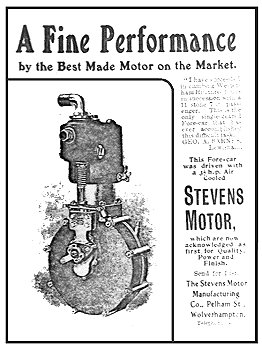 |
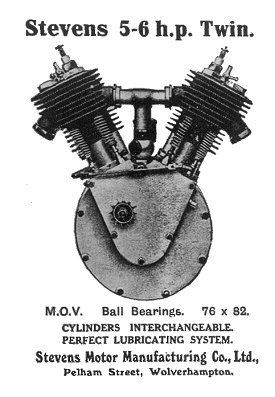
An advert from 'The Motor Cycle'. October 6th, 1909. |
Wearwell-Stevens motor bicycles continued to sell, but all of
this was not enough to keep the engine business going. The company
had several debtors including B.S.A.
A receiver was appointed on
17th March, 1907, and the brothers took other jobs to make ends meet.
Things improved in 1908 when Clyno of Thrapston, Northamptonshire
started to produce motorcycles using Stevens engines. Right from the
start they sold well and a brighter future seemed in sight. Around
this time Joe and Jack Stevens became well known figures,
due to their many successes in reliability trials, riding
Wolf machines.
Disaster struck at Wearwell in 1909 when it was discovered that
the Company Secretary, Mr. King, had been using the company's
money to gamble at pool in a local public house. A large sum of money
had disappeared, which resulted in Wearwell going into liquidation.
Mr. King tried to commit suicide, but William Clarke did
not bring any criminal charges against him, because he
discovered that one of his brothers was also involved. |
|
This came as a shock to the Stevens brothers as it
abruptly ended their association with Wearwell. Luckily as Wearwell had
paid them weekly they had not lost any money as a result of the
tragedy.
The brothers also acquired freehold premises in Retreat
Street, on the opposite side of the street to the Stevens Screw
Company's works.
They decided to produce their own motorcycles under the
A.J.S. name. This came from Jack Stevens' initials, because he was
the only one of the brothers to have two Christian names; Albert and John.
The brothers set up a new company
called A. J. Stevens & Company Limited on 14th November 1909.
The
Directors were Harry, Joe junior, Jack and George. They started with a
share capital of £1,000.
|
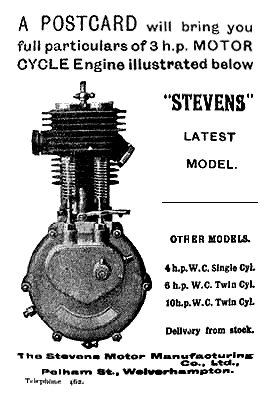
From 'The Motor Cycle'. 21st July,
1909. |
 |
|
 |
| Return to the Beginning |
|
Proceed to
A. J. Stevens |
|